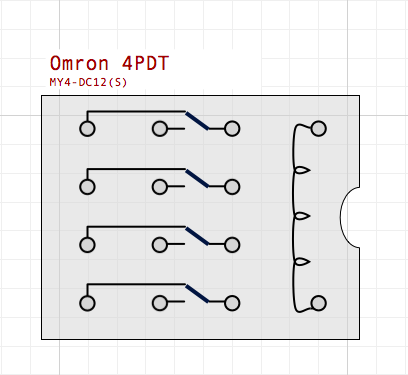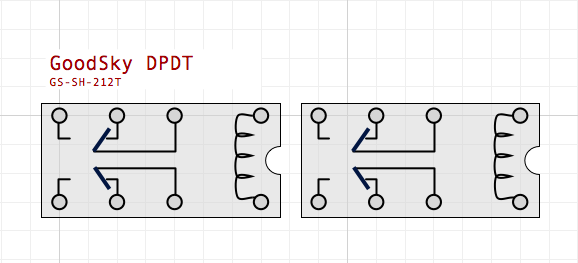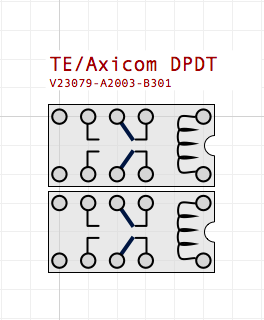If there’s one thing a relay computer needs a lot of it’s … erm … relays (of course) … which happens to be a bit unfortunate as relays, compared to the other parts of the computer, are rather expensive. The Dr Harry Porter Relay Computer (which my computer is based on) uses 415 x 4PDT (4 pole double toggle) relays in total. A comparable part is the Omron MY4-DC12(S) relay and a quick check online with Mouser (other suppliers are available ;) prices them around £3.20 a piece (excluding UK VAT @ 20%) … that’s just under £1600 including VAT which is a bit eye watering for a hobby project (the Harry Porter computer came to just over $5000 in total for everything). Also of note is that the MY4 relays are sized 28 x 21.5 x 36mm … not huge but big enough when you’ve got 415 of them wired together (again, see the Harry Porter computer to see exactly how big these machines can be). Here’s a scaled diagram of the MY4 relay showing the coil and four sets of double toggle contacts.

Many of the constructors of other relay computers I’ve read about have gone hunting on eBay for a job lot of relays or managed, in one case even, to persuade the manufacturer to donate them (to the RC-3 Relay Computer at the Museum of Computer Culture). I therefore find myself with a (self imposed) quandary … I’m too impatient to wait it out on eBay or to go scavenging but I’m too tight to spend all my pocket money on new relays. I also don’t want to make a behemoth computer either … I want to create something that can sit in the corner of a room not require me to move house to accommodate it (and certainly not with astronomical property prices in southeast England).
Well, it just so happens that a smaller relay appears to be a cheaper relay so that’s a good place to start looking. However, the first casualty of this miniaturisation drive is the number of poles on the relay … most are DPDT (double pole double toggle). This means twice the number of relays to get the same pole count and twice the number of coils. Luckily there’s plenty of choice in the smaller relay pool, prices are less than half those for the 4PDT relays and also the smaller coils tend to consume less power so doubling up is less of a concern. Actually, speaking of which, power consumption was another concern I had on my mind … the Omron MY4-DC12(S) consumes around 0.9W per relay and even though not every relay will be on at the same time you could be looking at 270W for 300 relays chowing down.
One place I started looking for relays was bitsbox which is where I get a lot of my bits and bobs from when playing with electronics (good prices and very reasonable delivery charges) and found the Good Sky GS-SH-212T DPDT which runs at 12V 0.2W (so down to 120W for 600 relays on the go). This is much more like it and came in at £1.95 inc VAT per relay (although that still means it could come to £1600 if 2 x 415 relays are needed [which I shouldn’t as not all poles are used on the 4PDTs]). Here’s a diagram at the same scale with two relays to make up the same pole count as the Omron 4PDT:

Taking this all a step further I started hunting out smaller and smaller relays and eventually settled on the TE Connectivity V23079A2003B301 DPDT (catchy part number ;) which runs at 12V 140mW (that’s 84W for 600 relays). These come in around £0.97 per relay from Mouser (exc VAT - so around £1.16 inclusive). Incidentally, both the GoodSky and the TE are through-hole PCB mounting so I can also use regular strip/pad/matrixboard to construct the computer (the Omron 4PDT, being industrial relays, require special mounting rails or similar). Here’s a diagram at the same scale again for this relay:

Oh, by the way, the choice of 12 as a relay coil voltage wasn’t an arbitrary one … relays come in all shapes, sizes and voltages but I plumbed for 12V in the end mainly due to it being a bit of sweet spot price wise and also it allowed me to use readily available 12V LEDs (which have an inline resistor built in) to save more space and simplify my project design (more on the LEDs and other components in a later post). Also, my bench power supply is well suited to pumping out 12V at the sort of power levels this relay computer will require.
I should say that one thing that always terrifies me (well, mildly perturbs at least) is buying electronic components as there’s so much choice out there and it takes a lot of concentration to match up part numbers to the data sheets to make sure you’re actually buying the right part (actually, this is another reason that I buy most of my bits from bits box for tinkering as they’ve preselected common parts for me … well, not me personally but you get the idea). The other thing that makes me uneasy is the quantity price breaks … the more you buy the less you pay. Sometimes the breaks can be quite dramatic however you have to be sure you’ve got the right part as you don’t want to receive 1000 green LEDs when you wanted red. Anyway, long story short, I put in an order for 125 of the TE relays with Mouser to get me going. However, after receiving everything else I ordered other than the relays I then looked on in horror as I saw the words ‘back order’ on the delivery note … the lead time had slipped back to 18 weeks (so delivery in March). Needless to say I’m going to try and get some more of the TE relays in the meantime and it looks like Farnell have stock so time to get the credit card out again :)
Next post I’ll start looking at how I will connect these relays together to make a 1-bit logic unit which will lead on to the design for the full 8-bit logic unit (which itself will form part of the ALU).
Realtime update: So, regular readers will know I’m playing catch up with the blog and I’m already busy soldering bits of the ALU together. If you really can’t wait for me to blog about how I’ve got to where I’m at now you’ll find some teaser videos at: here, here and here.